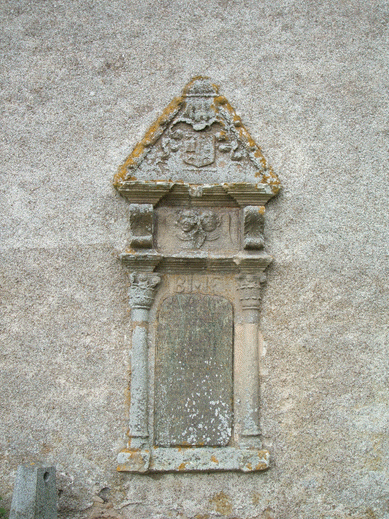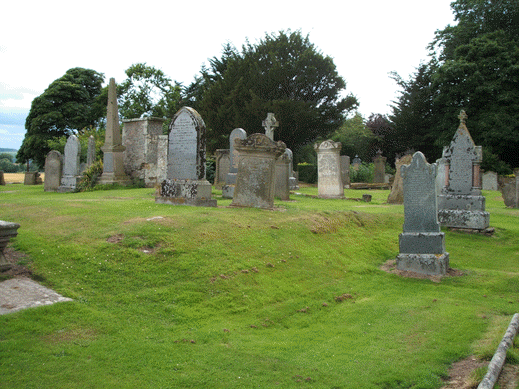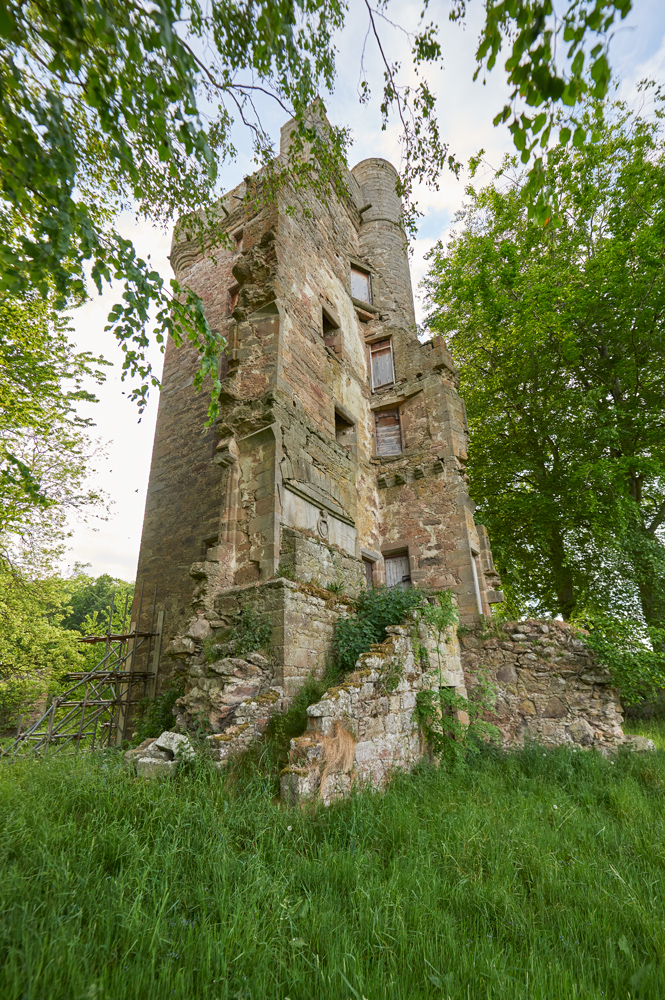Elgin Deanery
Alves
"Mary Kirk"
Parish Church: OS Ref: NGR: NJ 135630 H.E.S. No: NJ16SW 7 Dedication: Blessed Virgin Mary
Associated Chapels: Hill of Greeny {NGR: NJ 13_62_}; Kilbuyak {NGR: NJ 096603}; Kinloss {NGR: NJ 066615}; Knock of Alves {NGR: NJ 163629}.
Alves (Aluays, Alvays) Church is first mentioned in the thirteenth-century and the building, which is now a ruin, was in use until about 1769 when the 'new' Parish Church was built. What is thought to have been a fragment of the floor - possibly piece of a grave-slab - bore the date 1568. The last fragment of the choir wall which was still standing bore a tablet bearing the famous name of Beroald Innes and the date March 27, 1722. This is a Christian name still used by present-day members of the once powerful Innes family - this member was the parish minister (1677-1722). As the wall decayed it was no longer able to support the tablet which was then affixed to the east gable of the 'new' church.

From the time of Bishop Bricius (1208x1215), this church, along with that of Lhanbryde, formed the prebend of the Precentor of the cathedral in Elgin. The cure of souls was provided for by a vicar pensionar. From 1226, it, with the parish of Rafford and one dabhach of land in Alves, was created into a prebend for the newly created Succentorship of the cathedral in Elgin.
In 1229, a dispute having arisen between the Abbot and Convent of Kinloss on the one part, and the prebendaries of Forres, Rathed (Rafford), Alvays, and the rector of Keith on the other part, concerning the tithes of Strathisla and the lands of Aluays, an amicable settlement was reached amongst the many conditions of which was the yearly payment of 10s. to the Precentor by the Abbey. The lands of Cleves (Cloves NGR NJ 139613) Monachtie (Monaughty NGR NJ 126608) and Aslisk (Asliesk NGR NJ 112598) were church property. At the Second Reformation (1560) these lands passed to the Earl of Moray from the Crown, and in time, from him to the family of Brodie of Brodie. Amongst the kirklands of Alves was also the wood called the Cuthill.
In 1328, following a lengthy {and expensive} dispute between the Precentor (Roger) and the Succentor (Martin) over the location of the boundaries between Rafford and Alves, a settlement was eventually reached, but only after the intervention of papal judges delegate.2
The Earl of Moray was always 'patron' of this church.

of the Old Church at Alves.
In the middle of the parish, to the east, are Newton
Crammond3 recorded that, "A very fine-toned bell, rather heavier than for a hand bell, belongs to the Kirk Session of Alves. It is 6" high and 7½" wide at te mouth. On it in capitals is the inscription -
Kilbuyak (Kilnflat)
It is recorded that King William gave the whole lands of Burgin (Burgie), including the great forest of Kelbuthac, to Kinloss Abbey.5
In the sixteenth century, this castle and its estate were, for a number of generations, the property of a branch of the Dunbar family - the Dunbar lairds of Kilbuyak - as the consequence of a marriage agreement. In 1561, Katherine Reid, the sister of the Abbot of Kinloss (Walter Reid), was married to Alexander Dunbar, succentor, and afterwards Dean of Moray. By their contract of marriage the Abbot became bound to infeft the said Katherine and her heirs in the lands of West Grange, in the Regality of Kinloss.6

© Burgie Estates.
Kilnflat is said to be derived from Kilnflat = 'Kil-na-Vlait' = 'the church beside the stream.' The second part of the name is said to come from the Dutch 'vleit', meaning a stream, or lake, or marsh.
There is now a distillery on the site which first started to produce spirit (illicitly) in c1810, gaining a licence in 1829. Originally called Kilnflat, the distillery was renamed Glenburgie in 1878 after a period of disuse.
Parish Clergy:
(none known at this time.)
References.
1. Cramond (1900), p.108.
2. Registrum Episcopatus Moraviensis, no. 137, p. 150
3. Cramond (1900), p. 112.
4. The Burgerhuys family worked in Middelburg on Walcheren Island. Michael was the son of Jan Burgerhuys and he is considered to have founded more bells for Scotland than any of his Dutch countrymen. PSAS 82(1947-8), p. 175.
5. Stuart (1872), p. 109. The Charter recording this gift is dated to 15 March 1187x1203 and was signed at Elgin.
6. Stuart (1872), p. lxi. "By a charter dated at Kinloss 21st September 1566, Abbot Walter Reid conveyed to Mr. Alexander Dunbar, dean of Murray, and Katherine Reid his spouse, whom failing, to the heirs whomsoever of the said Katherine, the lands of Mekle Burgie, in the barony and regality of Kinloss."
"By another charter, dated at Elgin, 23rd January 1589, the said Mr. Alexander Dunbar, with consent of Katherine Reid, his spouse, conveyed in favour of their son Robert Dunbar, whom failing to his brother-german, Thomas Dunbar, whom failing to the heirs of the said Robert, the lands of Burgie, with the mansion and garden thereof, also Littil Burgie, otherwise called Lowriestoun, and Bogharbrie, reserving the granter's liferent."
Within a charter of 'protection' given to Kinloss by Richard [of Lincoln], Bishop of Moray, there is the following description - "By the gift of King William, all the land of Burgie which is on the north side of the King's Highway that runs from Forres to Elgin, namely from the brook towards the west which is at the exit of the forest, as far as the great forest of Kelbuthach and thence to the divided lands of Kinloss."
Finally, there is a charter of confirmation of the lands of Burgyn [Burgie] to Kinloss, given by King Alexander II, on 7 September, 1221, at Edinburgh. It records that these lands, on the King's command, had been perambulated by Malcolm, earl of Fife; Gilbert, archdeacon of Moray; Andrew, son of William Freskin; Archibald de Duffus; and Alexander and Henry, brothers of Bricius, bishop of Moray. They are described as being, "By the said marches delivered the land to the monks, namely from the great oak in Malvin, which the said earl Malcolm (first) caused to be marked with a "cross", as far as the Pictish Rune [stone] and thence to Tubernacrumkel and through it to Tubernafein and thence to Runetwethel and thence by the stream that runs through the marsh to the ford which is called Blakeford which is between Burgie and Ulern (Ulearn) [Blervie]." [Stuart (1872), 112-114; RRS., III., no. 66; REM., Carta Originalis, no 4, p. 456.]
Notes added at the foot ofre
this last charter - Tubernacrumkel is "ane well with ane thrawin [twisted, crooked] mouth or ane cassin well [twisted well] or ane crwik [crook] in it." Tubernafeyne "of [by] the grett [great] or kemppis[?] men callit ffenis is ane well." Rune Pictorum "the carne [cairn] of the Pethis [Picts] or the Pechts feildis [fields]." Malith "is the brow of ane hill."
Bibliography.
Cramond, W. (1900) The Church of Alves. Elgin: Courant & Courier.
Innes, C. (1837) Registrum Episcopatus Moraviensis: e pluribus codicibus consarcinatum virca A.D. MCCCC, cum continuatione diplomatum recentiorum usque ad A.D. MDCVVIII, Edinburgh: for the Bannatyne Club. [REM]
Stringer, K. () Regesta Regum Scottorum, III: the Acts of Alexander II., King of Scots, 1214-1249, Edinburgh: The University Press. (awaiting publication). [RRS, iii]
Stuart, J. (1872) Records of the Monastery of Kinloss, Edinburgh: for the Society of Antiquaries of Scotland.
e-mail: admin@cushnieent.com
© 2023 Cushnie Enterprises
